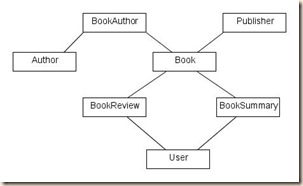[From the series - creating software books reviews grails web application]
In the previous posts I have created basic empty grails application. All the steps done to get up to this point are linked in this post. When the basic layout of the application is prepared it is obviously time to analyze domain objects. Domain objects in the grails are called GORM (grail's object relational mapping). Database schema is automatically generated from GORM objects and they probably represent the most powerful feature of the grails framework.
As software books reviews site is about providing reviews for the books the main features that need to be covered by application are following.
Visitor comes to the web site. From here he can navigate through existing books and read reviews and summaries. Review can be written on the site or link to the web site with the review can be provided. Summary is expressed as number (from 1 to 5) of some book aspects. Visitor can register and then he is able to post reviews and summaries for the books. Additionally there are some tasks for the administrator like: moderating books, posting new books...
If I try to express this short description as a list of user stories we get following:
As visitor I want to register.
As registered user I want to login.
As visitor I want to see books and reviews/summaries of the books.
As registered user I want to post book review.
As registered user I want to post summary.
As administrator I want to moderate books (this is probably epic).
Although user stories should be implemented one by one it is not a mistake to make an overview of the whole system. So described system can be pictured like this:
On the picture above I have depicted domain object classes that I will create for the sbr project. For those that already have some knowledge about GORM the class BookAuthor may be surprising. In the GORM it is possible to model "many-to-many" relationship directly. I don't like this way and most of the time I create additional domain class that is representing connection object. Of course you can use what ever approach but for me this is much more flexible because I can easily navigate in both directions in the relationship and even having custom logical methods in the connecting class - BookAuthor in this case.
Let me write few words about this domain objects model. As you can see the central place in the model plays the Book class. It is not surprise because sbr is more or less about books. For each book we want to have different details except reviews and summaries. Those details are Author and Publisher.
The relationship between Book and Author is many-to-many. This means that each book can have more than one author and each author can write more than one book. Thus domain object BookAuthor is created.
The relationship between Book and Publisher is many-to-one. This means that each book can have only one publisher. Or from the other point of the relationship, each publisher can publish many books.
Next interesting part of the diagram is BookReview and BookSummary and User. The logic here is that book review and book summary must be provided for an existing book by an existing user. There is no limit on the domain level how many reviews/summaries user can provide for the same book. This limit is set as a business logic. Registered user can post one review/summary per book while moderator can post many reviews per book and one summary per book.
Knowing all these we are ready to start with implementation. If you do it in hurry you can start with the book class. But as we already know that we will need possibility to register and we will need User class it is good moment to have a look into grails plugins.
Before you start implementing anything in the Grails it is good idea to see what is available from the Grails plugins. Very often functionality you need is already implemented as a plugin and you can simply reuse it. The same story is for registration and the User class. For software books reviews site I am using Spring security plugin (former Acegi security plugin). So you need to install this plugin. How to do that you can find in the plugins section of the Grails web site. After installing it create two roles: admin and user. This plugin offers out of the box login, logout, register pages and lot of useful methods that can be used in the application.
So in my next post I will install Spring (Acegi) security plugin, initialize default roles on the startup (if they are not initialized already) and then we will include register/login links on the home page and implement the first two user stories: As visitor I want to register and As registered user I want to login. So stay tuned.
P.S. Don't forget to write some review or post summary on the software books reviews.
